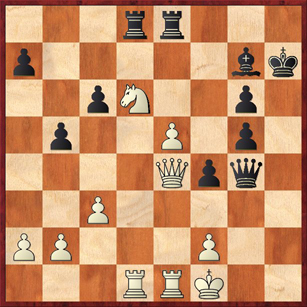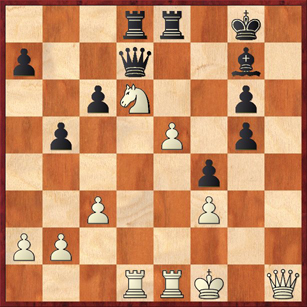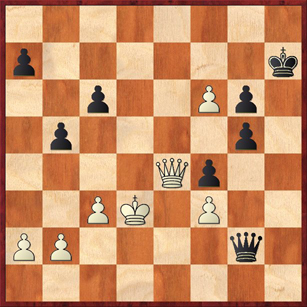At the CalChess Labor Day Tournament, they really should rename the Expert section. They should call it the “Worn-Out Old Experts and Teen-Age Hotshot Class-A Kids” section. That’s the way it was two years ago, when I played in the Expert section and lost to Nicholas Nip. There were more class-A players than experts in the section. And it was the same way this year! In both of my games I played teen-age 1900-somethings. I won my first game as Black against … somebody Samuel Bekker (updated 9/2/2008). Then I lost my second-round game against a floppy-haired kid named Evan Sandberg.
But you know what? I think I did a pretty good job of sticking to my “game plan,” described in the previous entry. And it was really great to have something else to focus on instead of whether I won or lost. It took a lot of the pressure off. My wife, Kay, says that some slips are to be expected when applying a new system. I felt good enough about my mental state that I think the system will work. It can’t guarantee victory, though, because the opponent has something to say about that. As you’ll see, young Mr. Sandberg played some first-rate moves, and deserved his victory.
To refresh readers’ memories, here was my game plan for the weekend:
- Play fifty percent mainstream openings. (Check. I did this in one game out of two.)
- Aim for and achieve a state of poise. (Check, for the most part. I felt psychologically very stable.)
- Avoid obvious (1- or 2-move) blunders. (Check.)
- Play for maximum piece activity at all times. (Check, except for one terrible exception — see below.)
- Play simple chess. (First game check, second game no check.)
Here is the key position from round two where I failed to follow the game plan.
Just before this I thought I was winning, but my opponent has just played the excellent move 25. … Rf8-e8! The time situation is intense for both sides. He played this move with less than a minute left on his clock, so he has to make 5 moves in under a minute. At this point I still have 3 minutes, but I quickly burned through two of them analyzing the complexities of 26. Nxe8 as well as 26. Qh1+. Seeing that I was under a minute, I had to make a quick decision and I opted for the “safer” move, 26. Qh1+, which defends my kingside. As soon as I made this move, I felt great misgivings, because it decentralizes my powerful queen. I abandoned part 4 of my game plan, which was to strive for maximum piece activity at all times.
Now I will confess a shameful thing. Part of the reason I picked this move was that I thought my opponent might fall into the trap 26. … Bh6? 27. Nxe8 Rxd1 28. Nf6+. True, with less than a minute on both of our clocks anything could happen, but still this violates a cardinal precept of chess, which is never never to assume that your opponent will fail to make the best move. He didn’t fall into the trap, but instead played 26. … Kg8 27. f3 Qd7! (diagram)
And with this neat move, he maintains the sort-of pin on the d6 knight. At this point Fritz says that White can still draw with 28. Qg2, but it’s complicated, and with less than a minute left, I can’t change plans now. So I played 28. Nxe8? Qxd1 29. Nxg7 Kxg7 30. Qg2 Qd3+. We’ve now made the time control, and I thought I still had chances to draw. However, Sandberg proved me wrong by playing the endgame in very convincing style. The computer also confirms that White is lost here.
What should I have done in the first position? The answer is to charge full speed ahead, and damn the torpedoes. I figured this out in my head as I was driving back home last night: 26. Nxe8! Rxd1 27. Nf6+! Bxf6 28. ef. I did look at this briefly over the board, but I didn’t play it because it looked too risky, and intuitively it seemed as if Black should at least have a draw by perpetual check. Thus, I was also guilty of overrating my position — thinking that I should still play for a win.
Black can in fact draw, but he has to play very carefully. White’s threats are far too dangerous for Black to play for a win. The only drawing line is 28. … Qh3+ 29. Ke2 Qg4+. And now if White plays for a win with 30. f3 Rxe1+ 31. Kxe1 Qg1+ 32. Ke2 Qg2+ 33. Kd3 (diagram), Black has only one saving move.
Black must play 33. … Kh6! The point is that if White does anything aggressive with his queen, he has to abandon the f-pawn and then Black will have a perpetual. The computer says that this is the only way for Black to draw.
OK, I lied — I didn’t work this all out in the car last night; I got to 29. … Qg4+ and figured it was a draw.
Unfortunately I don’t have time to show you some of the neat winning lines White has if Black plays anything other than 28. … Qh3+. You’ll have to work them out by yourself.
Moral: Fortune favors the brave!
Now, back to San Francisco for round three!





